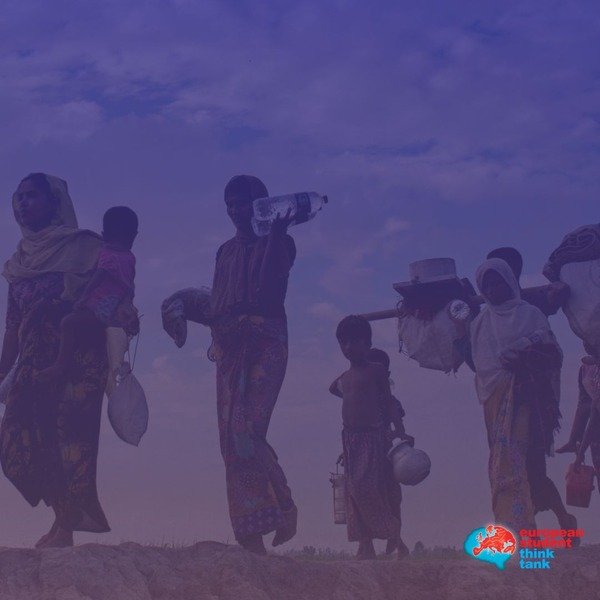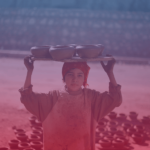
Written by: Chiara Zampolli
Edited by: Daniele Sorato
Introduction
Hannah Arendt’s concept of the “right to have rights” underscores the idea that human rights gain significance only when anchored in membership within a political community, a perspective further reinforced by Gündoğdu’s analysis of the necessity of political entities in upholding these rights (Arendt, 1976; Gündoğdu, 2012). Stateless individuals, of whom the Rohingya population is a fundamental example, face systematic barriers to claiming rights, exemplifying the paradox of human rights that cannot be claimed without citizenship and becoming mere abstractions without political protections (Staples, 2012). The article explores Arendt’s theory and critiques, the plight of stateless populations, and the role of international institutions, using the Rohingya as a case study to underscore the persistent vulnerabilities of stateless people (Southwick, 2021). Furthermore, it highlights the necessity of belonging to a political community as a fundamental prerequisite for claiming human rights.
The “Right to have Rights” is rooted in the idea that human dignity requires recognition within a political-legal framework. Arendt’s personal experiences with statelessness informed her perspective on the fragility of rights when individuals lack a state’s protection (Arendt, 1976). She observed that in the absence of citizenship, individuals are reduced to their bare humanity, stripped of the legal and political mechanisms needed to assert their rights. This insight remains profoundly relevant in today’s global landscape, where millions of individuals live without nationality or recognition.
This article aims to demonstrate that, despite international declarations asserting universal human rights, political membership remains essential to actualizing those rights. By examining the Rohingya crisis and the limitations of international institutions, the essay highlights the ongoing challenges faced by stateless populations and the urgent need for reforms to address their plight.
Hannah Arendt and the “Right to Have Rights”
Arendt’s “right to have rights”, articulated after World War II, contends that rights become meaningful only when claimed within a political community (Arendt, 1976). She argued that the “Rights of Man”, purportedly universal and inalienable, are ineffective without state protection (Gündoğdu, 2012). Stateless individuals, deprived of citizenship, embody this paradox as their lack of a state to reside in denies them a place to exercise rights (Kesby, 2012). Citizenship, therefore, becomes the gateway to accessing and asserting human rights (Weissbrodt & Collins, 2006).
Arendt criticized the abstract nature of “Rights of Man” as impractical outside political frameworks (Arendt, 1976). This perspective links human rights to the “right to citizenship”, emphasizing that political institutions are necessary to enforce these rights (Boudreaux, 2014). Statelessness, as Arendt views it, exposes the fragility of human rights by highlighting the gap between universal declaration and practical enforcement (Jain, 2022).
Critiques of Arendt’s framework, such as those by Jacques Rancière, argue that her analysis overlooks the democratic potential of rights declarations (Gündoğdu, 2012). While Rancière suggested that rights are not entirely dependent on state membership, the realities of statelessness reinforce Arendt’s position that human rights need a political foundation to be actionable (Jain, 2022). For instance, Alison Kebsy (2012) interprets Arendt’s theory as a call for the “right to enter and reside in a state”, highlighting the dependence of human rights on territorial and political inclusion (Weissbrodt & Collins, 2006).
Statelessness and the “Right to Have Rights”
Stateless individuals, defined as those not recognized as citizens by any country, face systematic barriers to claiming rights (UNHCR, 2023). According to the United Nations High Commissioner for Refugees (UNHCR), statelessness denies individuals the protections and entitlements afforded to citizens (UNHCR, 2023). Statelessness strips individuals of legal identity, leaving them vulnerable to discrimination, detention, and exclusion (Boudreaux, 2014). Furthermore, statelessness often stems from intentional state actions, as governments manipulate citizenship criteria to exclude specific populations (Jain, 2022).
The Universal Declaration of Human Rights (UDHR) asserts that “everyone has the right to a nationality” (United Nations, 1948). However, states retain the sovereign right to define citizenship criteria, often exacerbating statelessness (Jain, 2022). The 1954 Convention Relating to the Status of Stateless Persons recognizes the status of stateless individuals but fails to mandate pathways to citizenship or prevent future statelessness (Boudreaux, 2014). Stateless people remain largely dependent on states to claim rights, reinforcing Arendt’s notion that human rights require a political framework (Arendt, 1976).
The lack of oversight for treaties addressing statelessness, such as the 1954 and 1961 Conventions, further complicates the issue (Weissbrodts & Collins, 2006). Unlike the robust but controversial mechanisms for refugee protection, of which the Global Compact on Refugees is a relevant example, (Arnold-Fernández, 2023), stateless individuals receive limited support, leaving them in precarious legal and social positions (Southwick, 2021).
The Rohingya case: A portrait of Statelessness
The Rohingya people, an ethnolinguistic Muslim minority in predominantly Buddhist Myanmar (UNHCR, 2024), exemplify the plight of stateless individuals (Staples, 2012). Denied citizenship under Myanmar’s 1982 Citizenship Law, the Rohingya lack legal recognition and face systematic persecution (Southwick, 2021). As a result, they endure displacement, violence, and deprivation of basic rights (Uddin, 2015), making them the world’s largest stateless population (UNHCR, 2024). Myanmar’s government denies the Rohingya’s ethnic identity, leaving them without a “place in the world” to claim rights (Arendt, 1976).
Historically speaking, the term “Rohingya” comes from the Rakhine region and is contested by Myanmar’s Buddhist majority, who prefer the term “Bengalis”, denying the Rohingya’s historical presence in Myanmar. During British rule, Indian laborers, including Muslim Rohingya ancestors, were brought to Burma, leading to tensions with the ethnic Burman majority. Communal violence during World War II deepened divisions, with Rakhine Muslims aligning with the British and later seeking autonomy, which was rejected. According to the 1948 Constitution, Rakhine Muslims, including the Rohingya population, initially had citizenship and voting rights. Post-independence, Muslim insurgencies arose but were suppressed by the Burmese state (Fair, 2019). As Fair (2019) highlighted, 1991 also represented a tragic year for the Rohingya people: over 250,000 Rohingya fled to Bangladesh due to the confiscation of Muslim lands, forced labor, and mass displacement by the Myanmar military junta. In August 2017, severe violence in Myanmar’s Rakhine State forced over 742,000 Rohingya – half of whom were children – to flee to Bangladesh. They joined the thousands of people who had already been displaced by earlier conflicts, creating the world’s largest refugee camp in Cox’s Bazar (UNHCR, 2024; UNICEF, 2024).
Myanmar has systematically denied the Rohingya’s legitimacy as a group, exploited global Islamophobia by labelling them as terrorists, and leveraged regional political rivalries to avoid accountability. This emboldens genocidal regimes, setting a dangerous precedent (Fair, 2019). As Fair (2019) claimed, while Myanmar continues its ethnic cleansing, Bangladesh hosts the largest Rohingya refugee population, burdened by limited resources. Moreover, the international community’s inaction signals a grim message to aspiring perpetrators of genocide.
The Rohingya’s statelessness exacerbates their vulnerability (Southwick, 2021). Those who have fled to neighbouring countries like Bangladesh face overcrowded refugee camps, limited resources, and legal uncertainty (Uddin, 2015). Thailand and Malaysia have also informally deported Rohingya refugees, demonstrating the precariousness of their situation (Staples, 2012). Statelessness renders the Rohingya susceptible to arbitrary treatment and highlights the power of states in controlling citizenship and rights (Jain, 2022).
International efforts to address the Rohingya crisis have been insufficient (Southwick, 2021). While the UNHCR supports recognized refugees, unregistered Rohingya individuals remain excluded from assistance, living as illegal residents without protection (Uddin, 2015). The lack of a legal framework to address statelessness leaves the Rohingya in a cycle of displacement and marginalization (Boudreaux, 2014)
The refugee label itself is problematic, blending legal, social, and everyday concepts. UNHCR asserts that refugees are not migrants, with the goal of safeguarding their rights under international law. However, political actors may label them as migrants to deny their protection. The construction of the refugee category is influenced by political and legal considerations. The UNHCR’s data collection, for example, often excludes populations altogether or uses relative numbers, distorting global refugee trends. Furthermore, while refugees are generally defined by their forced displacement due to political violence or persecution, asylum seekers are individuals who seek protection within or at the borders of a host country. The distinction between these categories often becomes blurred due to the various ways different countries label and classify displaced individuals based on their specific legal frameworks (FitzGerald and Arar, 2018).
Currently, nearly 1 million Rohingya refugees live in overcrowded camps in Bangladesh, dependent on humanitarian aid (UNICEF, 2024). Life conditions are also getting worse: monsoon rains and natural disasters, such as Cyclone Mocha 2023, exacerbate risks like flooding, landslides, and disease (UNHCR, 2024), frequently damaging Rohingya camps. As the UNHCR (2024) reported, many live in flimsy shelters prone to destruction, with limited access to clean water, healthcare, and education. Furthermore, Rohingya refugees also seek asylum in countries like Malaysia, India, and Thailand, often undertaking perilous journeys. The challenges they have to face can just increase: according to UNHCR (2024) data, 95% of the Rohingya population rely on aid for survival, including shelter, food, and sanitation.
The Role of International Institutions
International institutions like the UN and the UNHCR are tasked with protecting stateless individuals, but their efforts are constrained by state sovereignty (UNHCR, 2023). Statelessness highlights the limitation of international law, which relies on state cooperation for enforcement (Jain, 2022). Furthermore, the UNHCR’s cautious approach to statelessness reflects the tension between addressing human rights violations and respecting state sovereignty (Weissbrodt & Collins, 2006).
Arendt’s critique of human rights declarations underscores the inadequacy of international protections for stateless individuals (Arendt, 1976). While the UNHCR has made strides in recognizing stateless populations, it lacks the authority to compel states to grant citizenship or provide robust protections (Uddin, 2015). Stateless individuals, therefore, remain dependent on the goodwill of states and international organizations, perpetuating their vulnerability (Southwick, 2021).
The controversial situation the Rohingya population has to face is also evident in the case supported by Nobel Laureate and former State Counsellor Aung San Suu Kyi at the International Court of Justice (ICJ) in The Hague (Beech and Simons, 2021). Suu Kyi defended Myanmar against genocide accusations concerning the Rohingya crisis, framing the violence as “intercommunal conflict” and “security measures” against insurgents, not a coordinated campaign of persecution. Moreover, she claimed Myanmar has taken steps to aid the Rohingya, including adopting a closure strategy for some camps and repatriation efforts. While at the ICJ, she criticized the international community for misunderstanding Myanmar’s ethnic complexities and chided “impatient” actors for their judgments. Lastly, she insisted Myanmar’s military justice system could address any violation (Beech and Simons, 2021).
As a result, critics condemned Suu Kyi for failing to address documented atrocities like mass killings, rapes, and forced displacements that forced 750,000 Rohingya to flee to Bangladesh in 2017. The UN labeled the violence as ethnic cleansing or even genocide, prompting Gambia to file a case against Myanmar at the ICJ on behalf of 57 Islamic nations, citing extensive testimony and a UN fact-finding report. Domestically, her stance aligns with widespread anti-Rohingya sentiment, garnering support ahead of elections as a move to solidify her political base. However, human rights advocates accuse her of forsaking human rights for nationalism, and international observers criticize her defense of the same military that once detained her. Many believe her high-profile defense at The Hague risks backfiring, drawing global attention to the plight of the Rohingya and intensifying scrutiny of Myanmar’s actions (Beech and Simons, 2021).
“Unfortunately she has totally taken sides, and she is now whipping up nationalism simply to become more popular,” stated U Maung Tun Khin, a Rohingya who traveled to The Hague from London to witness the hearings (Beech and Simons, 2021).
Conclusion
Hannah Arendt’s concept of the “right to have rights” remains a critical framework for understanding the limitations of human rights in a state-centric world (Arendt, 1976). Stateless individuals, such as the Rohingya population, exemplify the paradox of human rights that cannot be claimed without political membership (Staples, 2012). Despite international efforts to address statelessness, the lack of enforceable legal frameworks and state cooperation leaves millions of individuals without rights or protections (Jain, 2022).
This article has demonstrated that human rights, even though they are supposed to be a universal principle, require political and legal structure to be actionable. Statelessness lays bare the tension between the ideal of universal rights and the realities of a state-dominated system (Gündoğdu, 2012). The case of the Rohingya highlights the enduring challenges of statelessness and the need for stronger international mechanisms to address this issue and ensure that all individuals can have access to their fundamental rights (Southwick, 2021).
To achieve meaningful progress, states and international institutions must prioritize the inclusion and protection of stateless individuals. This includes creating pathways to citizenship, strengthening treaty enforcement, and holding states accountable for discriminatory practices (Jain, 2022). Until states and international institutions prioritize the inclusion of stateless individuals and implement such measures, the “right to have rights” will remain an elusive ideal, leaving millions in a state of vulnerability and exclusion (Boudreaux, 2014).
References
- FitzGerald, and Arar. (2018). The Sociology of Refugee Migration. Annual Review of Sociology, 44, 387-406.
- Arendt, H. (1976). The Origins of Totalitarianism. New York: Harcourt.
- Arnold-Fernandez, E. Emily. (2023) The Global Compact on Refugees: inadequate substitute or useful complement? Frontiers in Human Dynamics, from https://www.frontiersin.org/journals/human-dynamics/articles/10.3389/fhumd.2023.1238186/full
- Beech, H. and Simons, M. (2021). Aung San Suu Kyi Defends Myanmar Against Rohingya Genocide Accusations. May 24, 2021, from https://www.nytimes.com/2019/12/11/world/asia/aung-san-suu-kyi-rohingya-myanmar-genocide-hague.html
- Boudreaux, B. (2014). Statelessness, sovereignty, and international law: Promoting the “right to have rights”. In M. P. Lagon & A. C. Arend (Eds.), Human dignity and the future of global institutions (pp. 207–230). Georgetown University Press.
- Fair, C. C. (2019). The Making of the Rohingya Genocide and Myanmar’s Impunity. Current History, 118(807), 149–153.
- Gündoğdu, A. (2012). Perplexities of the rights of man: Arendt on the aporias of human rights. European Journal of Political Theory, 11(1), 4–24.
- Jain, N. (2022). Manufacturing statelessness. American Journal of International Law, 116(2), 237–288.
- Kesby, A. (2012). The right to have rights as a “place in the world”. In The right to have rights: Citizenship, humanity, and international law (pp. 13–38). Oxford University Press.
- Southwick, K. G. (2021). How statelessness matters to atrocity prevention: Lessons from the Rohingya case. Proceedings of the ASIL Annual Meeting, 115, 203–206.
- Staples, K. (2012). Contemporary statelessness: The Rohingya. In Retheorising statelessness: A background theory of membership in world politics (pp. 139–157). Edinburgh University Press.
- Uddin, N. (2015). State of stateless people: The plight of Rohingya refugees in Bangladesh. In R. Howard-Hassmann & M. Walton-Roberts (Eds.), The human right to citizenship (pp. 62–77). University of Pennsylvania Press.
- UN General Assembly. (1948). Universal Declaration of Human Rights. United Nations.
- UN General Assembly. (1954). Convention Relating to the Status of Stateless Persons. United Nations.
- UNHCR. (2024). Rohingya Refugee Crisis Explained. August 22, 2024, from https://www.unrefugees.org/news/rohingya-refugee-crisis-explained/
- UNICEF. (2024). Seven years after forced mass displacement of Rohingya from Myanmar, deadly attacks on children continue in Rakhine State. August 24, 2024, from https://www.unicef.org/press-releases/seven-years-after-forced-mass-displacement-rohingya-myanmar-deadly-attacks-children
- USA for UNHCR. (2023). Statelessness explained. Retrieved November 23, 2023, from https://www.unrefugees.org/news/statelessness-explained/
- Weissbrodt, D. S., & Collins, C. (2006). The human rights of stateless persons. Human Rights Quarterly, 28(1), 245–276.

 The ’Ndrangheta’s Infiltration and Threat to European Institutions
The ’Ndrangheta’s Infiltration and Threat to European Institutions  From Paper to Practice: How Grassroots Norms Undermine Gender Rights in Pakistan
From Paper to Practice: How Grassroots Norms Undermine Gender Rights in Pakistan  Exploited Childhoods: The Role of Global Corporations in Perpetuating and Mitigating Child Labour
Exploited Childhoods: The Role of Global Corporations in Perpetuating and Mitigating Child Labour  Human Rights Challenges in Addressing SLAPPs in Media, NGOs and Journalism in the EU
Human Rights Challenges in Addressing SLAPPs in Media, NGOs and Journalism in the EU 


